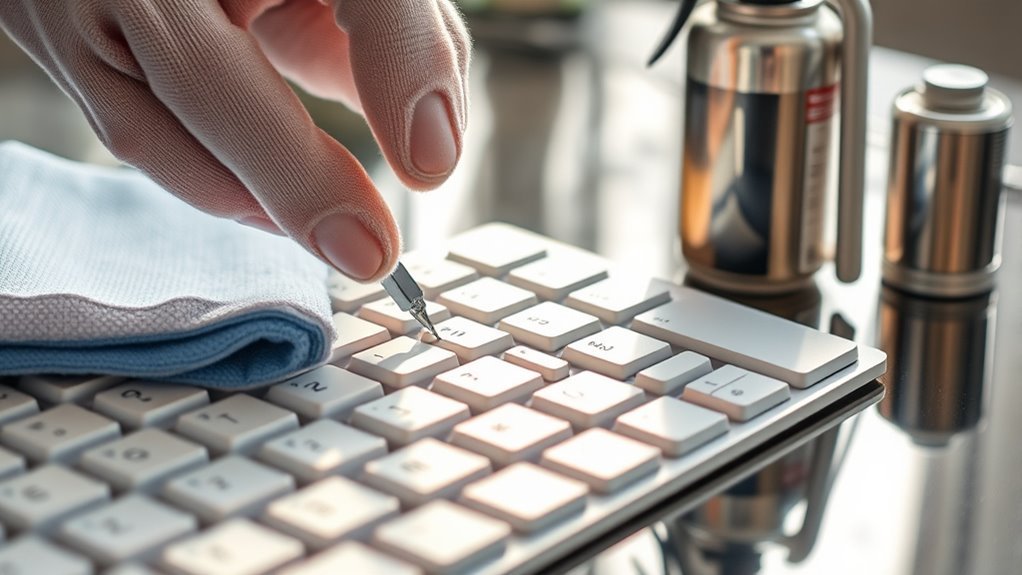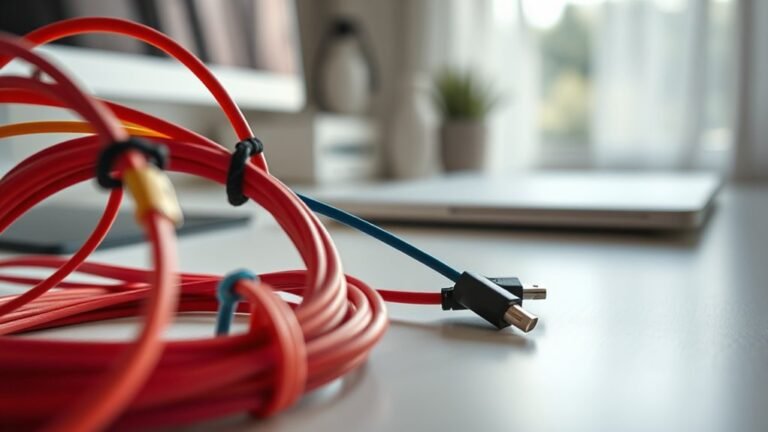How to Clean Keyboard
To clean your keyboard, first unplug it or turn it off. Shake or tap to remove loose debris, then use compressed air to blow out dust from between keys. Gently wipe the surface with a microfiber cloth lightly dampened with isopropyl alcohol for sanitizing. For deeper cleaning, carefully remove keycaps to access underneath. After drying, reassemble the keyboard by snapping keys back in place. Keeping this routine helps maintain hygiene and prolongs your keyboard’s life. Learn simple tips to keep it spotless regularly.
Tools Needed for Cleaning Your Keyboard

To clean your keyboard effectively, you’ll need a few essential tools. Start with a soft microfiber cloth to wipe away dust and fingerprints without scratching. A can of compressed air is vital for blowing out debris from between the keys, supporting regular keyboard maintenance. You’ll also want cotton swabs dipped in isopropyl alcohol to reach tight spaces and sanitize surfaces. For stubborn grime, a gentle cleaning brush or an old toothbrush works well. Keep a small bowl of mild soap and water handy if you plan to deep clean removable keycaps. Remember, your cleaning frequency depends on how much you use your keyboard; weekly light cleaning and monthly deep cleaning help maintain peak function and hygiene. Having these tools ready guarantees you can maintain your keyboard with freedom and ease.
Preparing Your Keyboard for Cleaning
Before you start cleaning, make sure to unplug your keyboard and turn off your device to avoid any damage. Next, gently shake or tap your keyboard to remove loose debris like crumbs and dust. Finally, gather all your cleaning supplies so everything is within reach for an efficient process.
Unplug and Power Down
Start by unplugging your keyboard from your computer or turning it off if it’s wireless. This step is crucial for keyboard safety, preventing accidental inputs and protecting internal components from electrical damage during cleaning. Managing power properly reduces risks and gives you the freedom to clean confidently. If your keyboard has a removable battery, take it out to guarantee no power remains. Avoid cleaning while the keyboard is connected or powered on, as this could cause short circuits or data loss. By powering down and disconnecting, you create a safe environment for thorough cleaning without interruptions. Remember, effective power management not only safeguards your device but also extends its lifespan, letting you enjoy a clean, fully functional keyboard without worry.
Remove Loose Debris
A few simple tools can help you remove loose debris from your keyboard quickly and effectively. Maintaining good keyboard hygiene starts with debris removal, which prevents buildup that can affect key function. Turn your keyboard upside down and gently shake it to dislodge crumbs and dust. Then, use a soft brush or compressed air to clear spaces between keys.
| Tool | Purpose | Tip |
|---|---|---|
| Soft Brush | Sweep debris away | Use gentle strokes |
| Compressed Air | Blow out dust | Short bursts, hold upright |
| Shake & Tap | Dislodge larger bits | Do over a trash bin |
These steps give you freedom from sticky keys and keep your keyboard fresh and responsive.
Gather Cleaning Supplies
Two or three key supplies will make cleaning your keyboard easier and more effective. Start with a can of compressed air to blow out dust and crumbs without damaging keys. Grab a microfiber cloth to wipe surfaces gently, ensuring you don’t scratch or leave lint behind. You’ll also want isopropyl alcohol (70% or higher) on cotton swabs or a soft cloth for disinfecting—this supports good keyboard hygiene by removing germs. Depending on your keyboard type, keycap pullers can help if you plan a deep clean. Remember, maintaining consistent cleaning frequency—like once a month—prevents buildup and keeps your keyboard fresh. With these supplies ready, you’re set to clean efficiently, preserving your freedom from sticky keys and grime.
Removing Loose Debris and Dust
Start by gently shaking and tapping your keyboard to dislodge any loose debris. Next, use compressed air to blow out dust from between the keys. Finally, brush the surface with a soft brush to remove remaining particles.
Shake and Tap
Before diving into deep cleaning, give your keyboard a gentle shake and tap to dislodge loose debris and dust. Using the shake technique, hold your keyboard upside down and gently shake it to release crumbs or particles trapped underneath the keys. Complement this with the tap method by softly tapping the back and sides to encourage stubborn dust to fall out. This simple step frees your keyboard from surface grime and makes further cleaning easier.
| Step | Action |
|---|---|
| 1 | Hold keyboard upside down |
| 2 | Gently shake to loosen debris |
| 3 | Tap sides/back softly |
| 4 | Inspect for remaining particles |
These quick moves keep your keyboard clear without hassle, letting you enjoy freedom from dirt.
Use Compressed Air
After shaking and tapping out loose debris, compressed air can help reach dust stuck in tight spaces between the keys. Hold the can upright and use short bursts to avoid moisture buildup. Direct the air pressure along the seams and crevices where dirt tends to accumulate. This cleaning technique is effective and quick, letting you clear out particles without removing keys or risking damage. Make sure to keep the can moving to prevent cold spots that could harm your keyboard. Using compressed air lets you maintain your keyboard’s cleanliness effortlessly, giving you the freedom to enjoy a smoother typing experience without sticky keys or grime. It’s a simple, powerful step in your keyboard cleaning routine that keeps your device in top shape.
Brush With Soft Brush
Although compressed air removes much of the debris, you’ll still want to use a soft brush to sweep away dust and particles lodged between keys. Soft brush techniques are essential for effective keyboard maintenance, helping you reach areas air can’t. Here’s how to do it right:
- Choose a soft-bristled brush, like a small paintbrush or makeup brush, to avoid scratching.
- Gently brush in between and around the keys, moving debris toward the edges.
- Periodically tap the brush to dislodge trapped dust and prevent buildup.
Cleaning Between and Under the Keys
Start by turning off your keyboard or unplugging it from your computer to prevent any accidental key presses. To clean between and under the keys, gently pry off keys using a flat tool for key removal. Keep track of the keys so you can easily perform key replacement later. Use compressed air or a soft brush to remove debris beneath the keys.
| Step | Action |
|---|---|
| 1. Key Removal | Carefully lift keys with a tool |
| 2. Debris Removal | Use compressed air or brush |
| 3. Surface Clean | Wipe under keys with a cloth |
| 4. Key Replacement | Press keys back into place |
This method lets you reclaim your keyboard’s freedom from grime and keeps it functioning smoothly.
Disinfecting Your Keyboard Safely

Since keyboards can harbor germs and bacteria, disinfecting them regularly is essential to maintain a healthy workspace. To do this safely, avoid using harsh chemicals that could damage your keyboard. Instead, follow these steps:
- Choose disinfecting wipes or an alcohol solution with at least 70% isopropyl alcohol to effectively kill germs without harming the keys.
- Lightly dampen a soft cloth or use a disinfecting wipe—never soak the keyboard—to prevent moisture from seeping inside.
- Gently wipe the surface and between keys, ensuring you cover all areas but avoid excessive pressure.
Drying and Reassembling Your Keyboard
Once you’ve finished disinfecting, you’ll need to let your keyboard dry completely before reassembling it. Use keyboard drying techniques like placing the keyboard in a well-ventilated area or gently patting it with a microfiber cloth. Avoid using heat sources that might damage components. Patience here guarantees no moisture remains that could cause malfunction.
For proper reassembly steps, carefully align each keycap with its switch stem and press down firmly until it snaps into place. Work methodically, starting from one side to the other to avoid missing keys. If you removed stabilizers or other parts, reinstall them first to maintain key stability. Once all keys are back, test your keyboard to confirm every key functions smoothly. Following these steps aids you in regaining full freedom with a clean, dry, and properly assembled keyboard.
Tips for Maintaining a Clean Keyboard Regularly

Keeping your keyboard clean doesn’t have to be a chore if you incorporate simple habits into your routine. Establishing keyboard hygiene habits and following a regular maintenance schedule can keep your device functioning well and looking fresh. Here’s how you can maintain your keyboard easily:
- Wipe daily: Use a microfiber cloth to remove dust and oils, preventing buildup.
- Avoid eating near your keyboard: This reduces crumbs and sticky residues.
- Schedule weekly deep cleans: Use compressed air and gentle cleaners to clear debris and sanitize keys.
Sticking to these tips frees you from frequent, overwhelming cleanups. By making keyboard care part of your routine, you guarantee a cleaner workspace and extend your keyboard’s lifespan without extra effort.
Frequently Asked Questions
Can I Use Compressed Air to Clean My Keyboard?
Think of your keyboard as a tiny city, where dust bunnies are the unwelcome visitors. You can definitely use compressed air to blow them away during keyboard maintenance. Just hold the can upright and spray in short bursts between the keys to avoid moisture buildup. This method keeps your keyboard clean without taking it apart. It’s an easy way to maintain freedom from sticky keys and keep your typing smooth and hassle-free.
How Often Should I Deep Clean My Keyboard?
You should deep clean your keyboard every 3 to 6 months to keep it in top shape. Regular keyboard maintenance prevents grime buildup and extends its lifespan. Use proper cleaning tools like a keycap puller, soft brush, and isopropyl alcohol for a thorough job. If you eat at your desk or share your keyboard, consider deep cleaning more often. Staying consistent means you’ll enjoy a cleaner, freer workspace without sticky keys.
Is It Safe to Submerge My Keyboard in Water?
Diving your keyboard into water is like sending it on a swim with no lifeguard—it’s risky and often disastrous. For keyboard maintenance, avoid submerging it to prevent electrical damage. Instead, use safer cleaning methods like compressed air, gentle wipes, or removing keycaps for a thorough clean. These techniques keep your keyboard fresh without drowning it, giving you the freedom to maintain it safely and effectively.
What Should I Do if Keys Stop Working After Cleaning?
If your keys stop working after cleaning, first try some basic troubleshooting tips: reconnect your keyboard, restart your device, and check for debris under the keys. If that doesn’t help, consider key replacement; many mechanical keyboards allow you to swap out faulty keys easily. You can also test your keyboard on another device to isolate the issue. Taking these steps helps you regain control without extra hassle or expense.
Can Cleaning Damage Mechanical Keyboard Switches?
Yes, cleaning can damage mechanical keyboard switches if you’re not careful. Switch durability depends on the cleaning techniques you use—avoid harsh chemicals or excess moisture that can seep inside. Instead, stick to gentle methods like compressed air or using isopropyl alcohol on a cotton swab. Being mindful of these will help preserve your switches’ lifespan while keeping your keyboard in great shape without risking damage.






